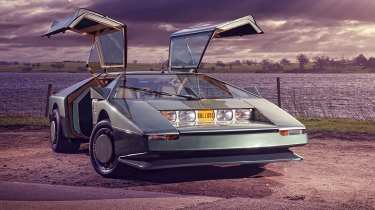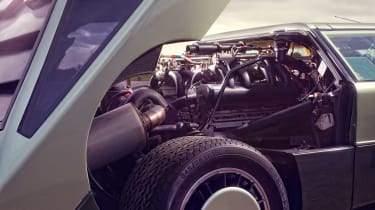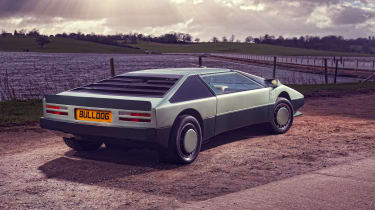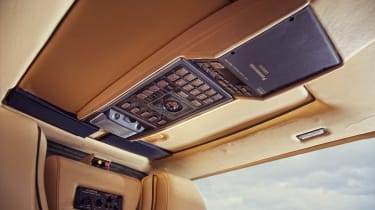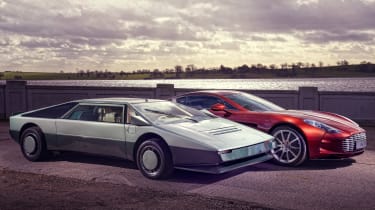Aston Martin Bulldog: the story of Aston's first hypercar
It was the cubist curiosity that was Aston's first hypercar: the Bulldog
A chilly, blustery, mid-January morning; a quiet car park beside a reservoir in rural Staffordshire; two near-identical Brian James race shuttles. The first has already disgorged its contents – Aston Martin’s own bronze-hued One-77 factory demonstrator – and now the rear door on the second transporter hisses skywards on its hydraulic struts. As it does, low winter sun floods inside and bounces off a vast chiselled expanse of aluminium and glass. As the trailer tilts and the dramatic wedge rolls down the ramps, the world holds its breath. If the first aim of a supercar is to stop you in your tracks and render you momentarily speechless, then Bulldog hits the bullseye.
We’re here to shoot our cover image, bringing together Aston Martin’s only two true hypercars, separated by three decades but bound together by the desire to create nothing less than the ultimate Aston, and also by a timeless capacity to command attention. Within minutes, the first of many passing motorists has pulled off the road to point a cameraphone at these two remarkable machines. ‘I recognise the Aston off the telly,’ he says (he means the One-77), ‘but what’s the other one?’ Ah, now there hangs a tale.
> Geely invests £234 million in Aston Martin shares to support brand revival
Bulldog. Not the prettiest name. Lamborghini, of course, had appropriated a fighting bull as its trademark, so ‘Bulldog’ might have been a clever allusion to the anticipated showdown between the Newport Pagnell hypercar and Sant’Agata’s latest missile. That car would have been a Countach – probably the LP500S version. Stand directly in front of the Bulldog, looking down at the broad bonnet and the huge, flat screen, and the visual similarities are obvious. And what a mouthwatering prospect that twin-test would have been.
In fact the origins of the name were rather more prosaic. Bulldog was a type of light aircraft favoured by Alan Curtis, who was chairman of Aston Martin when the project was first mooted in late 1976. But the Lamborghini parallel isn’t entirely frivolous, for there is little doubt what the motivation was – to show that Aston could build a super-sports car every bit as fast, ground-hugging and glamorous as anything from Modena.
The 1970s were frequently turbulent times for Aston, but in late 1976 Curtis was feeling particularly, ahem, bullish. Chief designer William Towns’s wedge-shaped Lagonda saloon had caused a minor sensation when it was revealed in prototype form at the London motor show in October, and now Towns was tasked with penning a mid-engined supercar. The results took the Lagonda’s simple, angular, almost architectural forms to their ultimate expression: the shape Towns presented to Curtis was brutally uncompromising. But would it work?
Engineering director Mike Loasby sketched the mechanical layout that would have to be packaged beneath that extraordinary silhouette – a beefy tubular steel chassis supporting the suspension and aluminium bodywork and cradling the familiar 5.3-litre Aston V8, but now of course positioned behind the driver, with the gearbox behind that – and in 1977 work began in a shed at Cranfield airfield, just down the road from Newport Pagnell. It didn’t progress very far. Loasby left to join DeLorean and Aston’s management were preoccupied with the Lagonda, whose transformation from concept to production car was proving painful and protracted. With a substantial number of orders from the Middle East waiting to be fulfilled, the partially built Bulldog was abandoned in its kennel.
In early 1979, however, with Lagonda production finally underway, Curtis’s thoughts returned to his supercar project (DP K9 as it was known within Aston, after the robot dog in 1970s Dr Who). And the person he tasked with making it a driving reality was Keith Martin.
Today a lecturer in mechanical engineering, then a 29-year-old development engineer who had joined Aston two years earlier, Martin has a book’s worth of memories from his three years as K9 project manager. He recalls how Curtis gave him a team of six, a cordoned-off area of the service department – and a year to get Bulldog ready for its press launch.
‘All we had,’ he says, ‘was a scale clay model, an incomplete tubular steel chassis, an engine and gearbox, a few unfinished panels, and a collection of sketches…’ There would be plenty of long days and late nights ahead. With a target speed in excess of 200mph, turbocharging was the obvious way to extract sufficient power from the V8, and the team went for a brace of Garrett AiResearch T04B blowers, one for each cylinder bank, with Bosch fuel injection in place of Aston’s then-customary Weber carbs. On the dyno, this explosive cocktail eventually produced over 700bhp, though Aston quoted 650bhp for the finished car.
The gearbox that sat behind was a ZF five-speed manual, similar to the one used by De Tomaso for the Pantera, while suspension was by double wishbones at the front and Aston’s traditional de Dion axle at the rear, chiefly because it took up less space. Packaging was certainly an issue. The finished car was vast: 15ft 6in long, well over 6ft wide and just 3ft 7in tall – substantially longer, wider and lower than a contemporary Ferrari Boxer. The tyres were Pirelli P7s – massively wide 345/55s at the rear, just like the Countach’s – and the brakes were vented and grooved 11.5in iron discs with four-piston callipers – the sort of brakes that were then the preserve of CanAm sportscars. Bladed wheel-trims, designed to draw cooling air over the discs, were another novelty in a road car.
And then there were the gullwing doors, electrically raised and lowered using a mechanism cunningly adapted from the V8 Volante’s powered hood. They still work today, if a little creakily on the passenger side. Were the electrics to fail, there were levers to open them manually, while the extreme angle of the sideglass meant that, even if the car rolled onto its roof, the doors could still be opened far enough for occupants to squeeze out (though I wouldn’t fancy trying it).
Just about everything beside the engine was unique to Bulldog. The enormous front screen was specially made by Triplex, while Lucas designed a unique six-bar linkage for the huge single wiper arm. The headlights, two for dipped, three for main beam, were revealed when the nose panel was dropped down by electric motor. Inside was a blend of traditional wood and leather but with LCD instrument displays. The seats, which look like they were lifted from a Gerry Anderson starfighter, were constructed specially for the Bulldog, and built around Keith Martin’s frame. ‘The reasoning was that I was of quite tall build, so if I could fit in, just about anybody could,’ he says, adding with a smile: ‘The thought that I’d have to do most of the development driving never entered my head…’
The first time the Bulldog turned a wheel in anger was on the two-mile high-speed bowl at the Millbrook proving ground, not far from Newport Pagnell, in November 1979, just eight months after Curtis reignited the project. ‘The car wasn’t finished and some of the panels were only held on with masking tape,’ Martin recalls. ‘We’d told ourselves we’d stick to 60-70mph, which at first I duly did. Next out was Steve Hallam [later director of race engineering at McLaren]. He got a bit carried away and was soon lapping at over 130mph. It was a clear, sunny day, and the sight and sound of the car sweeping around the banking was something I will never forget.
‘When I had my turn again I was lapping at about 135 when there was a big bang and a nose panel just flew off. We didn’t expect to be going that fast so quickly. But it was brilliant. Straight away it felt good.’
Months of testing, refining and calibrating followed. Wind tunnel sessions revealed that at a simulated 200mph there was around 450lb of lift at the rear; the addition of a crude-looking but undeniably functional lip reduced it to practically zero. So just how fast was it? It recorded 192mph at MIRA, and there were plans to take it to the Ehra-Lessien test track, on whose five-mile straight it might have achieved its theoretical 237mph maximum – or not. Hindsight suggests something in the 200-210mph region was probably more realistic. But hey, there was every indication that it would, indeed, exceed the double-ton – and would have been the first roadgoing supercar to do so. While it never hit the magic 200mph in its day, Le Mans class winner and Aston Martin development driver Darren Turner took a fully restored Bulldog to 205mph in June 2023, 45 years since its debut.
Keith Martin and his team hit their deadline, and the Bulldog was duly unveiled at the Bell Hotel in Aston Clinton on March 27, 1980. ‘It took a week of all-nighters to get the car finished in time,’ he recalls. Inside the hotel, the car was hidden behind curtains, and at the appointed hour Alan Curtis made a short speech, the curtains went up and simultaneously the Bulldog’s headlights blazed and the gullwing doors rose together – that was Keith Martin inside with his fingers on the buttons. The world’s press were there, and the Bulldog was big news. ‘We were heroes for the day,’ he remembers. ‘It was just brilliant.’
Bulldog, though, was already destined to remain a one-off. At one stage, Curtis had a buyer lined up: the Sultan of Oman, no less. ‘That was why we changed it from right to left-hand drive,’ says Martin. ‘But he dropped out to concentrate on more urgent matters following repercussions when Russia invaded Afghanistan!’ Curtis had also asked the team to cost-out a low production run – of 12, 18 or 25 – but when it came to the crunch Aston just didn’t have the resources to productionise its supercar. So instead it took on a role as PR machine, a showcase for Aston’s engineering talents, and a test-bed for new technologies.
‘We learned plenty from building the car,’ says Martin. ‘It was one of the first applications of twin turbos. The rear suspension was pretty trick, with a bell-crank system locating the de Dion tube. Then there was the special ICI-developed alumina fibre material on the engine bulkhead. It was designed to line blast furnaces – this was the first time it had been used on a car. The huge front screen was bonded-in with a technique which is now almost universal, and the LCD instruments were a development of the ones used in the early Lagonda and went into the later production models.’
Martin clocked up several thousand miles in the Bulldog during 1980. ‘It was a delight to drive,’ he says. ‘Best car I’ve ever driven. And extremely quick, obviously, but not in a scary way. There wasn’t the delay then the sudden kick you get with with smaller turbocharged engines. The power just kept coming. And the sound was very much V8, but very loud, even when we fitted silencers. You could pootle around in traffic and on the M1 at 2000rpm in 5th at 70mph. On the test track, however, you’d be changing gear from third into fourth at 170mph with another gear to go!
‘It was never just a show car. And any show it went to, I drove it there. It was a real car, and it did run, and it ran bloody quickly.’
The planned run at Ehra-Lessien got as far as installing a special diff and Pirelli producing a new set of tyres that were balanced and X-rayed to rule out any flaws. But by late 1980 Aston Martin was in the financial mire once again; Victor Gauntlett took the reins in 1981 and had other priorities. So when the Saudi prince Muhammed bin Saud agreed to buy the Bulldog for a price that covered virtually all the development costs – believed around £130,000 – Aston’s one and only mid-engined supercar was about to drive out of its Newport Pagnell lair for the last time.
‘The prince owned a fair bit of South Kensington at the time,’ says Keith Martin. ‘We showed off the car in the street below his apartment while the negotiations went on!’ Right to the end Bulldog was working its PR magic.
The story above first appeared in issue 001 of 'Vantage'.
